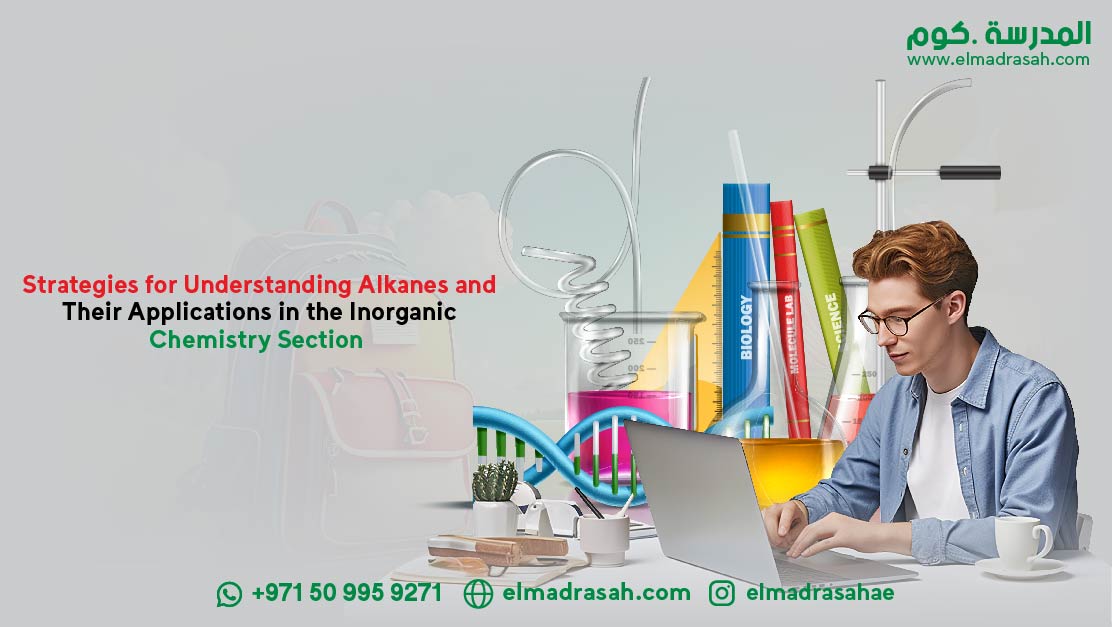
Do you want to prepare for the Emsat Inorganic Chemistry exam? Do you want alkanes and their applications in the inorganic chemistry section of the Emsat Inorganic Chemistry exam? Because of the importance of this part, students should focus on learning about important chemical reactions and the uses of alkanes in different fields. It is also useful to analyze practical examples of the applications of alkanes. In daily and industrial life, it helps students in elmadrasah.com team to achieve success in the Emsat exam and its applications in the practical field.
Alkanes and their importance in inorganic chemistry
Alkanes are considered one of the most important chemical compounds in inorganic chemistry, as they represent a large group of compounds that contain chemical bonds between carbon atoms only. The great importance of alkanes in inorganic chemistry is due to their ability to combine seamlessly with many other compounds and be used in many chemical reactions.
To achieve your success in understanding alkanes and their applications in the Emsat exam, here are tips to prepare for the exam by following some effective strategies:
- First of all, you must comprehensively understand the definition and properties of alkanes. Study their formation, molecular structure, and various chemical functions.
- Second, solve various practical exercises and exercises to understand the applications of alkanes in solving chemical problems. Make practical work part of your daily routine, where you can use various alkanes to prepare and react with other compounds.
- Furthermore, collaborating with classmates or asking for help from a teacher may contribute to a better understanding of alkanes and their applications. Benefit from the experiences and ideas of others and share with them the questions and problems you face in understanding alkanes.
This is what elmadrasah.com offers of these strategies, which can develop your skills in understanding alkanes and their applications in the Emsat Inorganic Chemistry exam, and succeed in this important aspect of inorganic chemistry, as this leading platform offers review courses for inorganic chemistry, including the following:
Chemical classifications of alkanes
Alkanes are classified according to the following:
- Classification according to the number of chemical bonds: Alkanes are classified according to the number of chemical bonds between carbon atoms. Alkanes can be saturated (contain only single chemical bonds) or branched (contain multiple chemical bonds).
- Classification by length: Knowing the length of alkanes (the number of carbon atoms in the chain) enables you to determine the chemical formula of the compound.
- Classification by Standard Hydrocarbons: Alkanes are classified according to the standard hydrocarbons that can be used to represent them. For example, alkanes with the chemical formula CnH2n+2 can be represented using the standard hydrocarbon butane.
Molecular formulas of alkanes
To understand alkanes in the Inorganic Chemistry section and their applications in the Emsat Chemistry exam, you must learn how to read and understand the molecular formulas of alkanes. Molecular formulas contain symbols for the elements and numbers that indicate the ratios between atoms. When reading molecular formulas, the number of carbons and hydrogens in a molecule can be determined.
Carbon atoms are labeled with the letters C and hydrogen atoms with the letters H. The numbers next to the letters indicate the number of atoms in the molecule.
Distinctive physical and chemical properties of alkanes
- One of the distinctive physical properties of alkanes is that they are insoluble in water but soluble in organic solvents such as benzene and acetone.
- Alkanes are also characterized by their chemical properties such as their susceptibility to complete combustion and the formation of end products carbon dioxide and water.
- Alkanes are also able to participate in carbon-carbon bond breaking reactions to form other organic compounds such as alkenes and alkynes.
Chemical reactions of alkanes
Alkanes participate in many chemical reactions that distinguish them and give them their ability to react and transform into other compounds. The most important of these interactions are:
- Combustion reaction: The combustion reaction is one of the most important reactions in which alkanes participate. When exposed to oxygen and in the presence of a spark or high heat, alkanes burn and turn into carbon dioxide and water. This reaction is important in many industrial processes and energy generation.
- Carbon-carbon bond-breaking reaction: Alkanes can participate in carbon-carbon bond-breaking reactions, where carbon bonds break and new bonds are formed to form other organic compounds such as alkenes and alkynes. This reaction is important in preparing desired organic compounds.
- Addition Reactions: Alkanes in Inorganic Chemistry participate in addition reactions, where functional groups or elements are added to the carbon in the alkane. Examples of this are halogen addition reactions and water addition.
The chemical reactions of alkanes may be used in many practical applications in different fields. Examples of these applications include:
- Fuel Production: Chemical reactions are used to convert alkanes into fuels such as gasoline, diesel, and natural gas.
- Preparation of chemicals: Combustion and addition reactions are used to prepare various chemicals, such as ethanol and ether.
- Preparation of plastic materials: The carbon-carbon bond breaking reaction is used in the preparation of various plastic materials, such as polyethylene and polypropylene.
Uses of alkanes in industry and agriculture
Alkanes act as nonpolar solvents in many industrial processes, such as metal cleaning and degreasing. Alkanes are used in the preparation of various chemicals in industries such as petrochemicals and pharmaceuticals.
- Alkanes are used in agriculture as solvents for pesticides and animal feed.
- Propane and butane are used as propellants in aerosol cans and personal care products such as hairspray and shaving cream.
- Alkanes, such as ethane, are used to operate burners in grills and home gas heaters.
- Pentane is used in the manufacture of gasoline and automobile fuel.
- All of this content is included in alkanes review courses with elmadrasah.com team of distinguished teachers for many tips to prepare for the chemistry exams.
The best methods for solving alkanes questions in the Emsat exam
Elmadrasah.com teachers help students prepare well to take the Emsat Chemistry exam, in addition to what is included in the general review of alkanes, but they provide some important rules and methods in this part so that you are able to understand and solve alkanes questions easily and accurately, as follows:
- Use illustrations: You can draw the structural structure of the alkane and label the atoms and bonds correctly. This will help you remember molecular shapes and solve questions with ease.
- Repeat the practice: Try to review the alkanes and solve their exercises regularly. The more you repeat constantly, the more chances you have to improve your performance and increase your speed in solving questions.
- Use visual memory: You can use pictures and illustrations of alkanes and put them somewhere you can see them regularly. When you remember the picture, you will be able to recall the names and formulas easily.
- Use available educational resources: Use books, lessons, and references on inorganic chemistry and alkanes. Read and understand the basic concepts and practical applications of alkanes.
- Timed practice: Solve the questions in a set time to simulate actual test conditions. Prepare a schedule and try to stick to it during training.
The most important rules and laws related to alkanes. One of the most important tips for exam preparation is to follow these rules
- Rule for following international nomenclature: The nomenclature of alkanes must be followed in accordance with international laws and recommendations. Names and formulas should be standardized and understandable to chemists around the world.
- Counting rule: You must know how to count the number of atoms in alkanes and determine their molecular formula. The molecular formula depends on the number of atoms that make up the alkane of Inorganic Chemistry.
- Name rule: You should familiarize yourself with the main letters and words used in naming alkanes. These include keywords such as “meth”, “eth”, “prop”, “but” and others.
By following these strategies and focusing on the main topics, and tips for exam preparation with the help of the best private Inorganic Chemistry tutor and elmadrasah.com team, you can improve your understanding of alkanes and their applications and increase your chances of success in the Emsat exam in the Inorganic Chemistry section.















